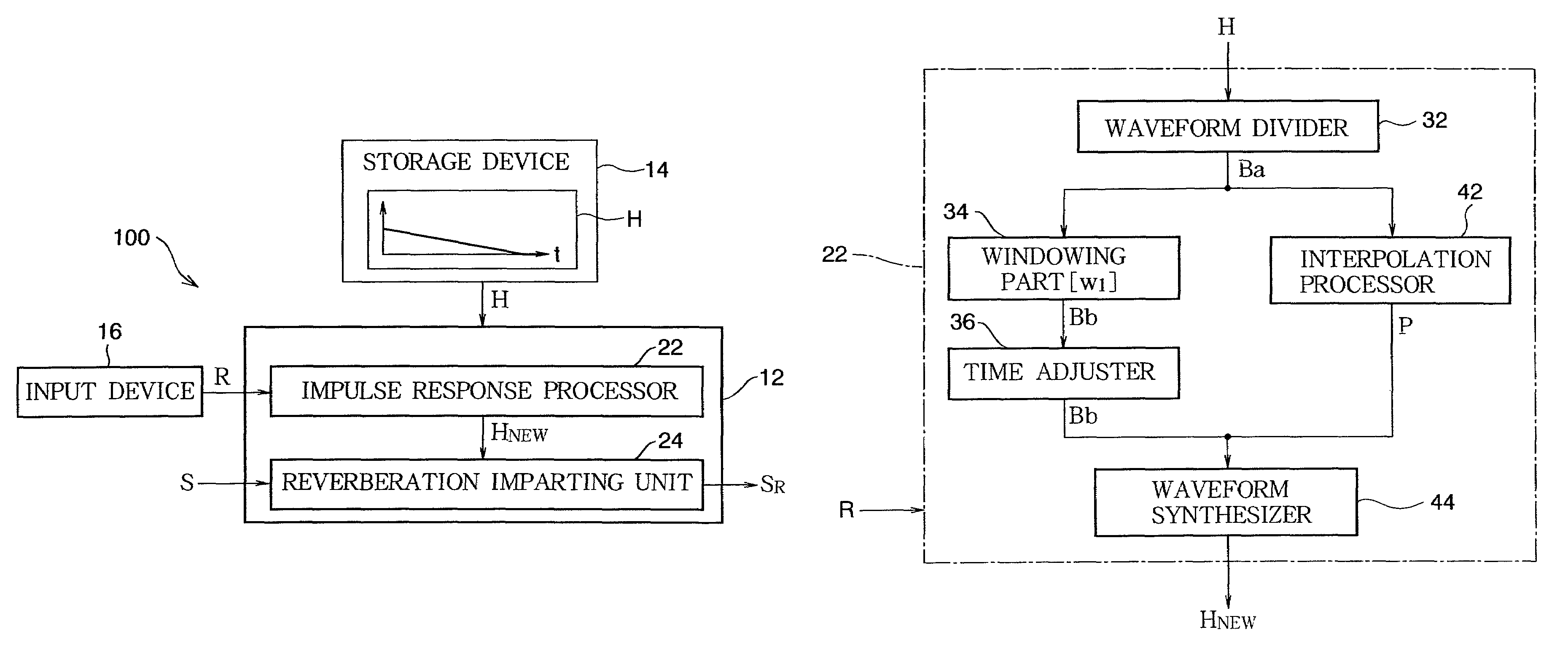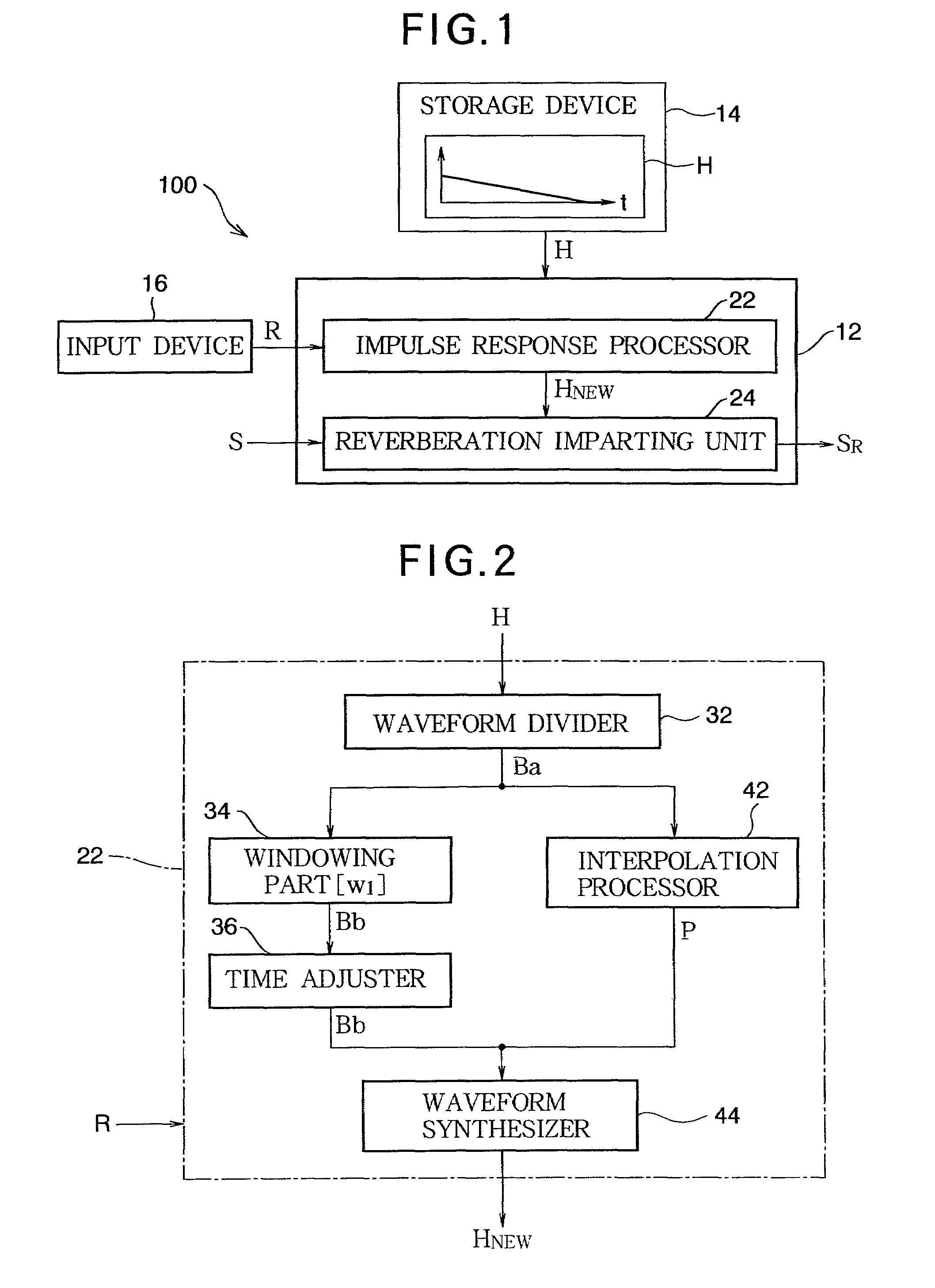Impulse response processing apparatus and reverberation imparting apparatus
a technology of reverberation and processing apparatus, applied in the direction of transducer details, instruments, electrical transducers, etc., can solve the problem of degrading the sound quality of the reverberant sound added to the sound signal
- Summary
- Abstract
- Description
- Claims
- Application Information
AI Technical Summary
Benefits of technology
Problems solved by technology
Method used
Image
Examples
first embodiment
A: First Embodiment
[0031]FIG. 1 is a block diagram of a reverberation imparting apparatus according to the first embodiment of the invention. A sound signal S representing the waveform of a (musical or vocal) sound is provided to a reverberation imparting apparatus 100. Examples of a sound source (not shown) that provides the sound signal S include a sound receiving device that generates a sound signal S according to an ambient sound or a playback device that sequentially acquires and outputs a sound signal S from a recording medium. The reverberation imparting apparatus 100 generates a reverberant sound signal SR by adding reverberation to the sound signal S and outputs the reverberant sound signal SR. The reverberant sound signal SR is provided to a sound emitting device (not shown) such as a speaker or headphones, which then reproduces the reverberant sound signal SR as a sound wave.
[0032]As shown in FIG. 1, the reverberation imparting apparatus 100 is a computer system that incl...
second embodiment
B: Second Embodiment
[0055]A description will now be given of the second embodiment of the invention. In the first embodiment, the waveform processor 54 reverses the waveform of the interpolation block Pa[i] generated by the averager 52 in the direction of the time axis. The waveform processor 54 of this embodiment generates an interpolation block Pb[i] by rotating the phase of the interpolation block Pa[i] generated by the averager 52. Elements in each of the following embodiments which are shared with the first embodiment are denoted by the same reference numerals and a detailed description thereof is appropriately omitted.
[0056]FIG. 8 is a block diagram of the waveform processor 54 in this embodiment. As shown in FIG. 8, the waveform processor 54 includes a converter 542, a phase shifter 544, and an inverse converter 546. The converter 542 converts the interpolation block Pa[i] into a signal of the frequency domain (i.e., a frequency spectrum), for example using Fourier transform....
third embodiment
C: Third Embodiment
[0058]The following is a description of the third embodiment of the invention. In the first embodiment, it is assumed that the scaling factor R of the reverberation time is equal to or less than 2. One purpose of this embodiment is to extend the reverberation time by a scaling factor R of greater than 2. In the case where the scaling factor R is less than or equal to 2 in this embodiment, the reverberation time is extended through the same procedure as the first or second embodiment.
[0059]FIG. 9 is a conceptual diagram illustrating the operation of this embodiment. When the scaling factor R is greater than 2, for example when R=2.5, the interval (N·R) between the central points C[i] and C[i+1] of the base blocks Bb[i] and Bb[i+1] generated through adjustment of the time adjuster 36 is greater than a section of 2N samples of the impulse response H. Accordingly, the magnitude of a section corresponding to the interval between the base block Bb[i] and the base block ...
PUM
 Login to View More
Login to View More Abstract
Description
Claims
Application Information
 Login to View More
Login to View More - Generate Ideas
- Intellectual Property
- Life Sciences
- Materials
- Tech Scout
- Unparalleled Data Quality
- Higher Quality Content
- 60% Fewer Hallucinations
Browse by: Latest US Patents, China's latest patents, Technical Efficacy Thesaurus, Application Domain, Technology Topic, Popular Technical Reports.
© 2025 PatSnap. All rights reserved.Legal|Privacy policy|Modern Slavery Act Transparency Statement|Sitemap|About US| Contact US: help@patsnap.com



